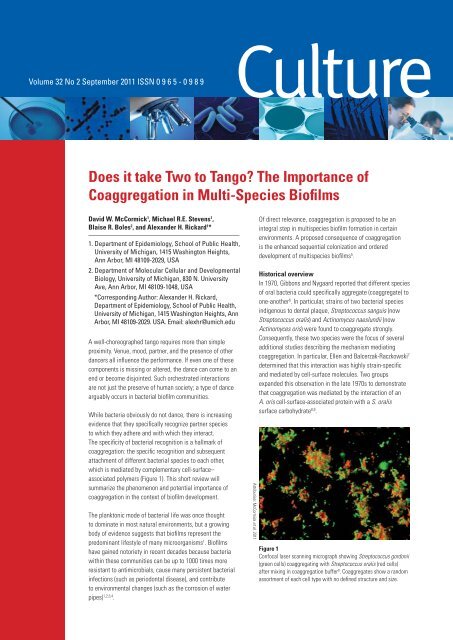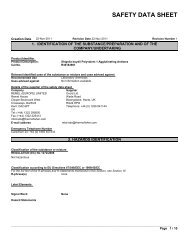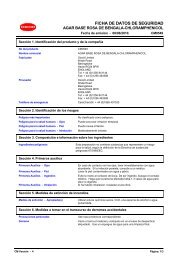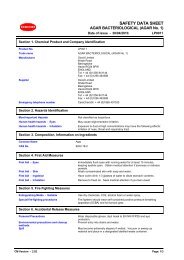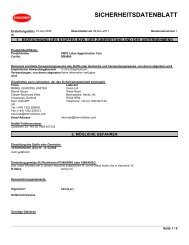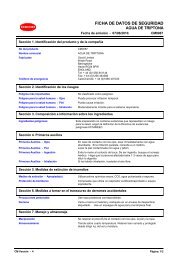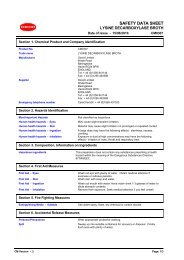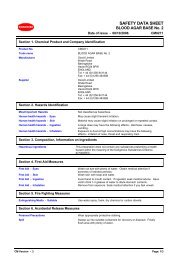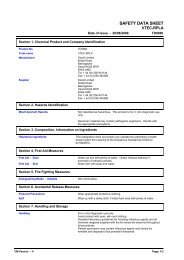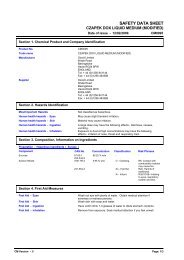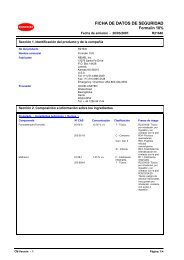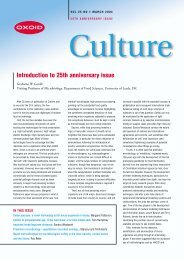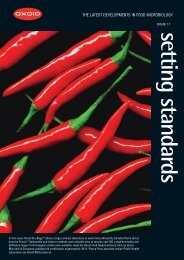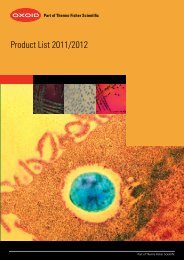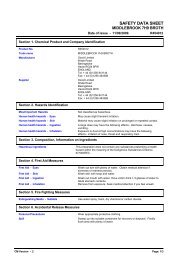The Importance of Coaggregation in Multi-Species Biofilms - Oxoid
The Importance of Coaggregation in Multi-Species Biofilms - Oxoid
The Importance of Coaggregation in Multi-Species Biofilms - Oxoid
You also want an ePaper? Increase the reach of your titles
YUMPU automatically turns print PDFs into web optimized ePapers that Google loves.
Volume 32 No 2 September 2011 ISSN 0 9 6 5 - 0 9 8 9 Culture<br />
Does it take Two to Tango? <strong>The</strong> <strong>Importance</strong> <strong>of</strong><br />
<strong>Coaggregation</strong> <strong>in</strong> <strong>Multi</strong>-<strong>Species</strong> Bi<strong>of</strong>i lms<br />
David W. McCormick 1 , Michael R.E. Stevens 1 ,<br />
Blaise R. Boles 2 , and Alexander H. Rickard 1 *<br />
1. Department <strong>of</strong> Epidemiology, School <strong>of</strong> Public Health,<br />
University <strong>of</strong> Michigan, 1415 Wash<strong>in</strong>gton Heights,<br />
Ann Arbor, MI 48109-2029, USA<br />
2. Department <strong>of</strong> Molecular Cellular and Developmental<br />
Biology, University <strong>of</strong> Michigan, 830 N. University<br />
Ave, Ann Arbor, MI 48109-1048, USA<br />
*Correspond<strong>in</strong>g Author: Alexander H. Rickard,<br />
Department <strong>of</strong> Epidemiology, School <strong>of</strong> Public Health,<br />
University <strong>of</strong> Michigan, 1415 Wash<strong>in</strong>gton Heights, Ann<br />
Arbor, MI 48109-2029. USA. Email: alexhr@umich.edu<br />
A well-choreographed tango requires more than simple<br />
proximity. Venue, mood, partner, and the presence <strong>of</strong> other<br />
dancers all <strong>in</strong>fl uence the performance. If even one <strong>of</strong> these<br />
components is miss<strong>in</strong>g or altered, the dance can come to an<br />
end or become disjo<strong>in</strong>ted. Such orchestrated <strong>in</strong>teractions<br />
are not just the preserve <strong>of</strong> human society; a type <strong>of</strong> dance<br />
arguably occurs <strong>in</strong> bacterial bi<strong>of</strong>i lm communities.<br />
While bacteria obviously do not dance, there is <strong>in</strong>creas<strong>in</strong>g<br />
evidence that they specifi cally recognize partner species<br />
to which they adhere and with which they <strong>in</strong>teract.<br />
<strong>The</strong> specifi city <strong>of</strong> bacterial recognition is a hallmark <strong>of</strong><br />
coaggregation: the specifi c recognition and subsequent<br />
attachment <strong>of</strong> different bacterial species to each other,<br />
which is mediated by complementary cell-surface–<br />
associated polymers (Figure 1). This short review will<br />
summarize the phenomenon and potential importance <strong>of</strong><br />
coaggregation <strong>in</strong> the context <strong>of</strong> bi<strong>of</strong>i lm development.<br />
<strong>The</strong> planktonic mode <strong>of</strong> bacterial life was once thought<br />
to dom<strong>in</strong>ate <strong>in</strong> most natural environments, but a grow<strong>in</strong>g<br />
body <strong>of</strong> evidence suggests that bi<strong>of</strong>i lms represent the<br />
predom<strong>in</strong>ant lifestyle <strong>of</strong> many microorganisms 1 . Bi<strong>of</strong>i lms<br />
have ga<strong>in</strong>ed notoriety <strong>in</strong> recent decades because bacteria<br />
with<strong>in</strong> these communities can be up to 1000 times more<br />
resistant to antimicrobials, cause many persistent bacterial<br />
<strong>in</strong>fections (such as periodontal disease), and contribute<br />
to environmental changes (such as the corrosion <strong>of</strong> water<br />
pipes) 1,2,3,4 .<br />
Attribution: McCormick et al. 2011<br />
Of direct relevance, coaggregation is proposed to be an<br />
<strong>in</strong>tegral step <strong>in</strong> multispecies bi<strong>of</strong>i lm formation <strong>in</strong> certa<strong>in</strong><br />
environments. A proposed consequence <strong>of</strong> coaggregation<br />
is the enhanced sequential colonization and ordered<br />
development <strong>of</strong> multispecies bi<strong>of</strong>i lms 5 .<br />
Historical overview<br />
In 1970, Gibbons and Nygaard reported that different species<br />
<strong>of</strong> oral bacteria could specifi cally aggregate (coaggregate) to<br />
one-another 6 . In particular, stra<strong>in</strong>s <strong>of</strong> two bacterial species<br />
<strong>in</strong>digenous to dental plaque, Streptococcus sanguis (now<br />
Streptococcus oralis) and Act<strong>in</strong>omyces naeslundii (now<br />
Act<strong>in</strong>omyces oris) were found to coaggregate strongly.<br />
Consequently, these two species were the focus <strong>of</strong> several<br />
additional studies describ<strong>in</strong>g the mechanism mediat<strong>in</strong>g<br />
coaggregation. In particular, Ellen and Balcerzak-Raczkowski 7<br />
determ<strong>in</strong>ed that this <strong>in</strong>teraction was highly stra<strong>in</strong>-specifi c<br />
and mediated by cell-surface molecules. Two groups<br />
expanded this observation <strong>in</strong> the late 1970s to demonstrate<br />
that coaggregation was mediated by the <strong>in</strong>teraction <strong>of</strong> an<br />
A. oris cell-surface-associated prote<strong>in</strong> with a S. oralis<br />
surface carbohydrate 8,9 .<br />
Figure 1<br />
Confocal laser scann<strong>in</strong>g micrograph show<strong>in</strong>g Streptococcus gordonii<br />
(green cells) coaggregat<strong>in</strong>g with Streptococcus oralis (red cells)<br />
after mix<strong>in</strong>g <strong>in</strong> coaggregation buffer 8 . Coaggregates show a random<br />
assortment <strong>of</strong> each cell type with no defi ned structure and size.
2<br />
Culture<br />
Initial studies by Gibbons and Nygaard 6 <strong>in</strong>dicated that coaggregation<br />
was uncommon - it was observed <strong>in</strong> just 23 <strong>of</strong> 253 total pairs.<br />
However, as research progressed and techniques and systems to<br />
study coaggregation improved <strong>in</strong> sensitivity, the ubiquity <strong>of</strong> this<br />
phenomenon began to be appreciated. It is now believed that most<br />
isolated oral bacteria are able to coaggregate to at least one other<br />
bacterium from the oral cavity 10 . <strong>The</strong>se <strong>in</strong>teractions are <strong>of</strong>ten<br />
specifi c at the stra<strong>in</strong> level and many <strong>in</strong>teractions are <strong>in</strong>tergeneric;<br />
between different species with<strong>in</strong> different genera. One fi nd<strong>in</strong>g<br />
that further popularized the importance <strong>of</strong> coaggregation with<strong>in</strong><br />
the oral research community was the discovery that certa<strong>in</strong> strict<br />
anaerobes coaggregate to aerobes/facultative anaerobes. For<br />
example, coaggregation <strong>of</strong> streptococci (facultative anaerobe) to<br />
Fusobacterium nucleatum (obligate anaerobe), was shown to allow<br />
for the survival <strong>of</strong> strict oral anaerobes <strong>in</strong> an aerobic environment 11 .<br />
This is because F. nucleatum can coaggregate with many oral<br />
species, <strong>in</strong>clud<strong>in</strong>g facultative anaerobes, such as streptocci, and<br />
obligate anaerobes, such as T. denticola.<br />
In particular, streptococci surround the F. nucleatum cells and form<br />
corncob-like aggregates 12 , which likely deplete local oxygen levels<br />
and create a microenvironment suitable for the growth <strong>of</strong> obligate<br />
anaerobes. <strong>The</strong> promiscuity <strong>of</strong> coaggregation <strong>in</strong>teractions displayed<br />
by F. nucleatum therefore enhances the <strong>in</strong>tegration and expansion<br />
<strong>of</strong> pathogenic populations (e.g. Porphymonas g<strong>in</strong>givalis and<br />
Treponema denticola) <strong>in</strong> the oral dental plaque bi<strong>of</strong>i lm communities.<br />
In addition to serv<strong>in</strong>g as a mechanism to enhance the ability <strong>of</strong><br />
bacteria to adhere to develop<strong>in</strong>g oral bi<strong>of</strong>i lms, many oral researchers<br />
consider coaggregation to be a process that enhances successional<br />
attachment <strong>of</strong> oral bacteria to dental plaque bi<strong>of</strong>i lms, and promotes<br />
the expansion <strong>of</strong> certa<strong>in</strong> bacterial populations with<strong>in</strong> multispecies<br />
dental plaque bi<strong>of</strong>i lm communities. It is also hypothesized that<br />
coaggregation may serve as a mechanism which contributes to the<br />
progression from health to periodontal disease 13 .<br />
Although the phenomenon <strong>of</strong> coaggregation was orig<strong>in</strong>ally thought<br />
to be exclusive to the oral cavity 10 , reports describ<strong>in</strong>g coaggregation<br />
<strong>in</strong> environments other than the oral cavity began to appear <strong>in</strong><br />
the late 1980s. Among the fi rst reports was that <strong>of</strong> Reid and<br />
colleagues, who demonstrated that coaggregation occurs between<br />
specifi c stra<strong>in</strong>s <strong>of</strong> Escherichia coli and Lactobacillus casei isolated<br />
from the human urogenital tract 14 . <strong>The</strong> authors proposed that<br />
coaggregation <strong>in</strong>teractions could reduce the pathogenicity <strong>of</strong> E. coli<br />
by br<strong>in</strong>g<strong>in</strong>g the two organisms <strong>in</strong>to close proximity and allow<strong>in</strong>g<br />
L. casei to <strong>in</strong>hibit the growth <strong>of</strong> E. coli. Soon after, Vandevoorde<br />
and coworkers reported upon coaggregation between lactobacilli<br />
<strong>in</strong> the chicken gut 15 . Other papers followed, <strong>in</strong>clud<strong>in</strong>g those that<br />
demonstrated that coaggregation occurs between bacteria isolated<br />
from the human gut and can<strong>in</strong>e dental plaque. In the last decade,<br />
coaggregation has also been reported to occur <strong>in</strong> environmental<br />
ecosystems, <strong>in</strong>clud<strong>in</strong>g freshwater and wastewater bi<strong>of</strong>i lms.<br />
However, the mechanism mediat<strong>in</strong>g coaggregation between<br />
freshwater bacteria is more complicated than that mediat<strong>in</strong>g<br />
coaggregation between oral bacteria. Specifi cally, the ability<br />
<strong>of</strong> freshwater bacteria to coaggregate is <strong>in</strong>fl uenced by nutrient<br />
availability 16 and environmental conditions, such as pH and ionic<br />
strength <strong>of</strong> solutions 17 . It is possible that similar complications have<br />
slowed the identifi cation <strong>of</strong> coaggregation between bacteria <strong>in</strong><br />
other environmental samples. As <strong>in</strong> human societies, where dances<br />
only occur under particular circumstances, freshwater bacterial<br />
coaggregation occurs as a consequence <strong>of</strong> specifi c environmental<br />
cues and conditions.<br />
Mechanism beh<strong>in</strong>d coaggregation partnerships<br />
Most studies <strong>of</strong> the mechanisms mediat<strong>in</strong>g bacterial coaggregation<br />
have focused on human oral bacteria 10 . Interest<strong>in</strong>gly, the limited<br />
studies <strong>of</strong> coaggregation between bacteria <strong>in</strong> environments other<br />
than the oral cavity have shown similarities. For example, studies <strong>of</strong><br />
coaggregation between bacteria from both the human oral cavity and<br />
freshwater bi<strong>of</strong>i lms have shown that prote<strong>in</strong>aceous adhes<strong>in</strong>s are<br />
<strong>of</strong>ten expressed on the cell-surface <strong>of</strong> one species,which recognizes<br />
and b<strong>in</strong>ds to the polysaccharide-conta<strong>in</strong><strong>in</strong>g receptor on the cellsurface<br />
<strong>of</strong> the partner species 5 .<br />
Adhes<strong>in</strong>s are prote<strong>in</strong>s found either on the bacterial outer membrane,<br />
cell wall, or on surface appendages, such as fi mbriae 5,10,18 . <strong>The</strong>se<br />
structures allow for bacterial surface attachment to host tissue, solid<br />
surfaces or other microorganisms. Bacteria can express multiple<br />
adhes<strong>in</strong>s 5,19 . In many <strong>in</strong>stances, coaggregation is reversed by<br />
add<strong>in</strong>g one or more simple sugars to a suspension <strong>of</strong> coaggregat<strong>in</strong>g<br />
bacteria, <strong>in</strong>dicat<strong>in</strong>g that many bacterial receptor molecules conta<strong>in</strong> a<br />
carbohydrate moiety and that attachment is mediated by lect<strong>in</strong>-like<br />
adhes<strong>in</strong>s. This lect<strong>in</strong>-saccharide <strong>in</strong>teraction between coaggregat<strong>in</strong>g<br />
partners is found <strong>in</strong> both oral 10 and aquatic bacteria 16,20 . However,<br />
it should be noted that there have also been reports <strong>of</strong> non-lect<strong>in</strong><br />
adhes<strong>in</strong>s (viz. prote<strong>in</strong>-prote<strong>in</strong> <strong>in</strong>teractions) mediat<strong>in</strong>g coaggregation<br />
between pairs <strong>of</strong> bacteria 5,10 .<br />
In order for coaggregation to occur, there must be a complementary<br />
polymer, <strong>of</strong>ten a polysaccharide, on the coaggregation partner to<br />
which adhes<strong>in</strong>s can b<strong>in</strong>d. This polysaccharide possesses a specifi c<br />
b<strong>in</strong>d<strong>in</strong>g site, or motif, that is recognized by the (lect<strong>in</strong>-like) adhes<strong>in</strong> <strong>of</strong><br />
the complementary stra<strong>in</strong>. It is important to note, however, that while<br />
the receptor is a polysaccharide, it could be a component or part <strong>of</strong> a<br />
complex with other molecules/polymers, e.g. lipopolysaccharides or<br />
glycoprote<strong>in</strong>s. In the case <strong>of</strong> polysaccharide coaggregation receptor<br />
polymers presented by oral streptococci, studies have shown that<br />
subtly different receptor polysaccharides (RPS) can be expressed. As<br />
described by Yoshida et al. 21 , six different structural types <strong>of</strong> RPS <strong>in</strong><br />
oral streptococci have been identifi ed through their reactions with<br />
specifi c antibodies and lect<strong>in</strong>-like adhes<strong>in</strong>s. Each RPS consists <strong>of</strong><br />
unique units <strong>of</strong> repeat<strong>in</strong>g hexa- or heptasaccharides and conta<strong>in</strong>s a<br />
receptor to which adhes<strong>in</strong>s <strong>of</strong> specifi c coaggregat<strong>in</strong>g partners are<br />
able to b<strong>in</strong>d. Yoshida and coworkers 21 suggest that coaggregation<br />
mediated by RPS adhes<strong>in</strong> <strong>in</strong>teractions play a direct role <strong>in</strong> the<br />
formation <strong>of</strong> multispecies bi<strong>of</strong>i lms and allow for mutualistic/<br />
synergistic <strong>in</strong>teractions, which require close contact between<br />
different species.<br />
A commonly over-looked coaggregation phenomenon is the<br />
possibility that multiple adhes<strong>in</strong>s and multiple receptors can mediate<br />
coaggregation between a particular pair <strong>of</strong> bacteria. Kolenbrander<br />
et al. 22 addressed this question <strong>in</strong> 1985 and showed that a<br />
coaggregat<strong>in</strong>g pair should be defi ned as unimodal if coaggregation is<br />
<strong>in</strong>hibited by the heat treatment <strong>of</strong> one stra<strong>in</strong> but not the other. This<br />
description suggests that a heat-sensitive prote<strong>in</strong> adhes<strong>in</strong>- and a<br />
heat-<strong>in</strong>sensitive polysaccharide receptor mediate the coaggregation<br />
<strong>in</strong>teraction. Conversely, a coaggregation <strong>in</strong>teraction should be defi ned<br />
as bimodal if coaggregation is only <strong>in</strong>hibited by the heat treatment <strong>of</strong><br />
both stra<strong>in</strong>s (suggest<strong>in</strong>g an adhes<strong>in</strong>-receptor and a receptor-adhes<strong>in</strong><br />
<strong>in</strong>teraction between the coaggregat<strong>in</strong>g pair or possibly a prote<strong>in</strong>prote<strong>in</strong><br />
<strong>in</strong>teraction).<br />
Unfortunately, the identifi cation <strong>of</strong> bacterial coaggregation adhes<strong>in</strong>s<br />
and complementary receptors has focused primarily on those species
that exist <strong>in</strong> the human oral cavity. However, as the identifi cation <strong>of</strong><br />
coaggregat<strong>in</strong>g bacteria <strong>in</strong> other environments cont<strong>in</strong>ues, it is highly<br />
likely that the number <strong>of</strong> known prote<strong>in</strong>s and carbohydrate moieties<br />
responsible for coaggregation will <strong>in</strong>crease and their structures and<br />
functions determ<strong>in</strong>ed.<br />
Ecological relevance<br />
Natural fl ow<strong>in</strong>g environmental conditions can impose strong selective<br />
pressure aga<strong>in</strong>st planktonic growth. <strong>The</strong> oral cavity is an excellent<br />
example <strong>of</strong> such a selective pressure, as it is an environment with<br />
large amounts <strong>of</strong> fl uid, a high shear rate, and prompt transfer to an<br />
unfavorable environment (the stomach) if microbes fail to adhere<br />
to surfaces. Surfaces to which bacteria can adhere <strong>in</strong>clude teeth,<br />
g<strong>in</strong>giva, or other cells with<strong>in</strong> bi<strong>of</strong>i lms. In this environment, bacteria<br />
that have evolved the ability to coaggregate could potentially<br />
have a higher relative bi<strong>of</strong>i lm-fi tness than those that are unable<br />
to coaggregate. <strong>Coaggregation</strong> could therefore be a primary<br />
determ<strong>in</strong>ant for the relatively similar oral microbiota observed<br />
between healthy <strong>in</strong>dividuals as well as the same reproducible and<br />
sequential development <strong>of</strong> multispecies bi<strong>of</strong>i lms after toothbrush<strong>in</strong>g 4 .<br />
Unlike the oral cavity, freshwater environments have highly variable<br />
fl ow rates, rang<strong>in</strong>g from static glacial lakes to rapid rivers. Research<br />
has shown that different shear rates select for freshwater bi<strong>of</strong>i lms<br />
with differ<strong>in</strong>g species composition and also select for different<br />
proportions <strong>of</strong> <strong>in</strong>tra-species aggregat<strong>in</strong>g bacteria (a phenomenon<br />
called autoaggregation) and coaggregat<strong>in</strong>g species <strong>of</strong> bacteria 23 .<br />
A further consideration is that freshwater coaggregation ability<br />
varies with the metabolic status <strong>of</strong> the cells 16 . It is therefore feasible<br />
that coaggregation can be switched “on” or “<strong>of</strong>f”, depend<strong>in</strong>g<br />
upon environmental conditions, and thereby contributes to bi<strong>of</strong>i lm<br />
development or bi<strong>of</strong>i lm dispersion, which would allow for bacteria to<br />
traverse freshwater environments more effectively.<br />
With respect to ecological relevance, coaggregation is proposed<br />
to contribute towards enhanced bi<strong>of</strong>i lm colonization, community<br />
succession and <strong>in</strong>terbacterial <strong>in</strong>teractions with<strong>in</strong> the bi<strong>of</strong>i lm 4,5,19,24 .<br />
This phenomenon allows for the development <strong>of</strong> a complex<br />
multispecies community. <strong>The</strong>se multispecies bi<strong>of</strong>i lms consequently<br />
function as highly structured communities, and <strong>in</strong>teractions between<br />
bi<strong>of</strong>i lm bacteria can conceivably be commensal, synergistic or<br />
parasitic. <strong>Coaggregation</strong> likely has a multifaceted role <strong>in</strong> multispecies<br />
bi<strong>of</strong>i lm development.<br />
An unquantifi ed phenomenon that likely has a multifaceted<br />
role <strong>in</strong> multispecies bi<strong>of</strong>i lms<br />
By virtue <strong>of</strong> cellular juxtaposition and species specifi city, a number<br />
<strong>of</strong> <strong>in</strong>terspecies <strong>in</strong>teractions could occur as a consequence <strong>of</strong><br />
coaggregation (Figure 2). <strong>The</strong>se <strong>in</strong>teractions <strong>in</strong>clude genetic<br />
exchange, cell-cell signal<strong>in</strong>g, cross-species protection, metabolite<br />
exchange, and contact-dependent signal<strong>in</strong>g. <strong>The</strong> vast majority <strong>of</strong><br />
studies that have identifi ed these possible types <strong>of</strong> <strong>in</strong>teractions<br />
between coaggregat<strong>in</strong>g bacteria have focused on stra<strong>in</strong>s from the<br />
human oral cavity. Of particular <strong>in</strong>terest is the potential role <strong>of</strong><br />
coaggregation <strong>in</strong> enhanc<strong>in</strong>g cell-cell signal<strong>in</strong>g. A recent review by<br />
Kolenbrander and coworkers highlighted the potential importance<br />
<strong>of</strong> coaggregation <strong>in</strong> br<strong>in</strong>g<strong>in</strong>g species <strong>in</strong> close proximity. Specifi cally,<br />
that bacterial juxtaposition with<strong>in</strong> multispecies bi<strong>of</strong>i lms may enhance<br />
cell-cell signal<strong>in</strong>g between the component species via the production<br />
and detection <strong>of</strong> auto<strong>in</strong>cuder-2 24 . Egland et al. have also shown that<br />
metabolic communication (an outcome <strong>of</strong> metabolite exchange) may<br />
occur between Streptococcus gordonii-Veillonella atypica <strong>in</strong> dual-<br />
Attribution: McCormick et al. 2011<br />
Culture 3<br />
Figure 2<br />
Diagram highlight<strong>in</strong>g processes, other than specifi c cell-cell<br />
attachment, that coaggregation may enhance or alter <strong>in</strong> multispecies<br />
bi<strong>of</strong>i lms.<br />
species oral bi<strong>of</strong>i lms 25 . Not only has coaggregation been shown to<br />
facilitate metabolic communication between bacteria with<strong>in</strong> the oral<br />
cavity, but coaggregation has been shown to facilitate metabolite<br />
transfer/exchange between methanogens and archaea <strong>in</strong> mar<strong>in</strong>e<br />
environments. <strong>Coaggregation</strong> <strong>in</strong> this environment was strongly<br />
dependent on the growth substrate, <strong>in</strong>dicat<strong>in</strong>g that bacteria are able<br />
to selectively coaggregate <strong>in</strong> order to maximize metabolic potential<br />
under a specifi c condition 26 . An <strong>in</strong>trigu<strong>in</strong>g, albeit unstudied, possibility<br />
is that coaggregation between microbes <strong>in</strong> mar<strong>in</strong>e snow helps to<br />
establish a parsimonious food cha<strong>in</strong> and <strong>in</strong>crease the energetic<br />
potential <strong>of</strong> metabolites.<br />
<strong>Coaggregation</strong> also likely plays a role <strong>in</strong> cross-species protection<br />
(Figure 2). As described earlier, coaggregation between streptococci<br />
and F. nucleatum probably contributes to the protection <strong>of</strong> other<br />
anaerobic species from oxygen 11 . <strong>Coaggregation</strong> may also confer<br />
cross-species protection to antimicrobials. <strong>The</strong> potential for such<br />
a role was fi rst put forward by Gilbert and coworkers 3 . Another<br />
<strong>in</strong>terest<strong>in</strong>g possibility is that coaggregation enhances genetic<br />
exchange between bacteria 27 , for example, through conjugation<br />
or the release and uptake <strong>of</strong> extracellular DNA dur<strong>in</strong>g bi<strong>of</strong>i lm growth<br />
or cell death 28 . F<strong>in</strong>ally, an <strong>in</strong>trigu<strong>in</strong>g recent study by Inagaki et al.<br />
<strong>in</strong>dicates that contact-dependent expression may occur <strong>in</strong> the oral<br />
pathogen Tannerella forsythia as a consequence <strong>of</strong> coaggregation<br />
with other oral species 29 . This fi nd<strong>in</strong>g opens up the possibility that<br />
the actual act <strong>of</strong> coaggregation alters the expression <strong>of</strong> certa<strong>in</strong> genes<br />
<strong>in</strong> response to physical contact.
4<br />
Culture<br />
Attribution: McCormick et al. 2011<br />
<strong>Coaggregation</strong> as a common bi<strong>of</strong>i lm phenomenon<br />
One <strong>of</strong> the most famous images <strong>in</strong> microbiology is Anton van<br />
Leeuwenhoek’s draw<strong>in</strong>g <strong>of</strong> human oral bacteria. Us<strong>in</strong>g his<br />
revolutionary microscope, he visualized and drew the oral bacterial<br />
cells he observed. However, a key facet <strong>of</strong> these organisms’ lifestyle<br />
was not highlighted <strong>in</strong> these early images: bacteria are social<br />
entities, and they have the ability to aggregate and specifi cally<br />
coaggregate. In order to convey this message, we drew the analogy<br />
<strong>of</strong> coaggregation to a dance and asked, “Does it take two to tango?”<br />
Simply put, the answer is no - it likely takes more, and these<br />
<strong>in</strong>teractions predom<strong>in</strong>antly occur <strong>in</strong> complex multispecies bi<strong>of</strong>i lm<br />
communities. Comb<strong>in</strong>ations <strong>of</strong> specifi c species <strong>in</strong> close proximity<br />
could conceivably provide for a bi<strong>of</strong>i lm that possesses a greater<br />
comb<strong>in</strong>ed phenotypic, genetic, metabolic and/or signal<strong>in</strong>g potential<br />
Published Papers<br />
20<br />
18<br />
16<br />
14<br />
12<br />
10<br />
8<br />
6<br />
4<br />
2<br />
than the <strong>in</strong>dividual component species alone 30 . <strong>Coaggregation</strong><br />
likely plays a role <strong>in</strong> form<strong>in</strong>g some <strong>of</strong> these associations and<br />
mediat<strong>in</strong>g <strong>in</strong>teractions both with<strong>in</strong> the oral cavity and <strong>in</strong> the<br />
broader environment. As to whether coaggregation is a ubiquitous<br />
phenomenon and what other the roles it plays <strong>in</strong> bi<strong>of</strong>i lm<br />
development, only more research studies will reveal the answer.<br />
Indeed, as coaggregation receives more attention (Figure 3) and<br />
as the microbial properties and composition <strong>of</strong> bi<strong>of</strong>i lms <strong>in</strong> other<br />
environments are <strong>in</strong>vestigated, the role <strong>of</strong> coaggregation <strong>in</strong> other<br />
environmental bi<strong>of</strong>i lms will be clarifi ed. Such an understand<strong>in</strong>g would<br />
not only improve our fundamental understand<strong>in</strong>g <strong>of</strong> multispecies<br />
bi<strong>of</strong>i lm development, but it could aid <strong>in</strong> the development <strong>of</strong> novel<br />
approaches to control multispecies bi<strong>of</strong>i lms.<br />
0<br />
1975 1980 1985 1990 1995 2000 2005 2010<br />
Year<br />
Figure 3<br />
Graph show<strong>in</strong>g the <strong>in</strong>crease <strong>in</strong> research and review publications that report upon or consider aspects <strong>of</strong> bacterial coaggregation. Enumeration <strong>of</strong><br />
publications per year was performed on Pubmed (www.ncbi.nlm.nih.gov/pubmed) us<strong>in</strong>g the search terms “coaggregation” and “bacteria” for each<br />
year up to 2009. Note: the fi rst paper to show coaggregation was by Gibbons and Nygaard 6 , but this paper was not <strong>in</strong>cluded <strong>in</strong> this graph because the<br />
authors did not describe the <strong>in</strong>teraction as “coaggregation”.
References<br />
1. Yang, L., Liu, Y., Wu, H. et al. (2011) Current understand<strong>in</strong>g <strong>of</strong> multi-species bi<strong>of</strong>i lms. Int. J. Oral. Sci.<br />
3:74-81.<br />
2. Coetser, S.E. and Cloete T.E. (2005) Bi<strong>of</strong>oul<strong>in</strong>g and biocorrosion <strong>in</strong> <strong>in</strong>dustrial water systems. Crit.<br />
Rev. Microbiol. 31:213-32.<br />
3. Gilbert, P., Maira-Litran, T., McBa<strong>in</strong>, A.J. et al. (2002) <strong>The</strong> physiology and collective recalcitrance <strong>of</strong><br />
microbial bi<strong>of</strong>i lm communities. Advances <strong>in</strong> Microbial Physiology 46:202-56.<br />
4. Kolenbrander, P.E., Palmer, R.J.Jr., Rickard, A.H. et al. (2006) Bacterial <strong>in</strong>teractions and successions<br />
dur<strong>in</strong>g plaque development. Periodontol 2000 42:47-79.<br />
5. Rickard, A.H., Gilbert, P., High, N. J. et al. (2003) Bacterial coaggregation: an <strong>in</strong>tegral process <strong>in</strong> the<br />
development <strong>of</strong> multi-species bi<strong>of</strong>i lms. Trends <strong>in</strong> Microbiology 11:94-100.<br />
6. Gibbons, R.J. and Nygaard M. (1970) Interbacterial aggregation <strong>of</strong> plaque bacteria. Archives <strong>of</strong> Oral<br />
Biology 15:1397-400.<br />
7. Ellen, R.P. and Balcerzak-Raczkowski, I.B. (1977) Interbacterial aggregation <strong>of</strong> Act<strong>in</strong>omyces<br />
naeslundii and dental plaque streptococci. Journal <strong>of</strong> Periodontal Research 12:11-20.<br />
8. Cisar, J.O., Kolenbrander, P.E. and McIntire F.C. (1979) Specifi city <strong>of</strong> coaggregation reactions<br />
between human oral streptococci and stra<strong>in</strong>s <strong>of</strong> Act<strong>in</strong>omyces viscosus or Act<strong>in</strong>omyces naeslundii.<br />
Infection and Immunity 24:742-52.<br />
9. McIntire, F.C., Vatter, A.E. Baros, J. et al. (1978) Mechanism <strong>of</strong> coaggregation between Act<strong>in</strong>omyces<br />
viscosus T14V and Streptococcus sanguis 34. Infection and Immunity 21:978-88.<br />
10. Kolenbrander, P.E. (2000). Oral microbial communities: bi<strong>of</strong>i lms, <strong>in</strong>teractions, and genetic systems.<br />
Annual Rev. Micro. 54:413-37.<br />
11. Bradshaw, D.J., Marsh, P.D., Watson, G.K. et al. (1998) Role <strong>of</strong> Fusobacterium nucleatum and<br />
coaggregation <strong>in</strong> anaerobe survival <strong>in</strong> planktonic and bi<strong>of</strong>i lm oral microbial communities dur<strong>in</strong>g<br />
aeration. Infection and Immunity 66:4729-32.<br />
12. Lancy, P., Dirienzo, J.M., Appelbaum, B. et al. (1983) Corncob formation between Fusobacterium<br />
nucleatum and Streptococcus sanguis. Infection and Immunity 40:303-9.<br />
13. Jakubovics, N.S., and Kolenbrander, P.E. (2010) <strong>The</strong> road to ru<strong>in</strong>: the formation <strong>of</strong> disease-associated<br />
oral bi<strong>of</strong>i lms. Oral Diseases 16:729-39.<br />
14. Reid, G., McGroarty, J.A., Angotti, R. et al. (1988) Lactobacillus <strong>in</strong>hibitor production aga<strong>in</strong>st<br />
Escherichia coli and coaggregation ability with uropathogens. Canadian J. Micro.34:344-51.<br />
15. Vandevoorde, L., Christiaens, H. and Verstraete, W. (1992) Prevalence <strong>of</strong> coaggregation reactions<br />
among chicken lactobacilli. J. App. Bacterio. 72:214-9.<br />
16. Rickard, A.H., Leach, S.A., Buswell, C.M. et al. (2000) <strong>Coaggregation</strong> between aquatic bacteria<br />
is mediated by specifi c-growth-phase-dependent lect<strong>in</strong>-saccharide <strong>in</strong>teractions. App. Env. Micro.<br />
66:431-4.<br />
17. M<strong>in</strong>, K.R., Zimmer, M.N. and Rickard, A.H. (2010) Physicochemical parameters <strong>in</strong>fl uenc<strong>in</strong>g<br />
coaggregation between the freshwater bacteria Sph<strong>in</strong>gomonas natatoria 2.1 and Micrococcus<br />
luteus 2.13. Bi<strong>of</strong>oul<strong>in</strong>g 26:931-40.<br />
Food, Fungi and Mycotox<strong>in</strong>s: an update<br />
Ailsa D. Hock<strong>in</strong>g & John I. Pitt<br />
CSIRO Food and Nutritional Sciences, North Ryde,<br />
NSW 2113, Australia<br />
Introduction<br />
Despite advances <strong>in</strong> harvest<strong>in</strong>g, storage and process<strong>in</strong>g technologies,<br />
fungal spoilage still has a major economic impact on world food<br />
supplies. Even though we have a much greater understand<strong>in</strong>g <strong>of</strong> the<br />
causal factors, fungal spoilage <strong>of</strong> commodities, fruits and vegetables<br />
seems to be as great a problem now as it has ever been. A recent<br />
report by FAO 1 estimates that, <strong>in</strong> areas such as Asia and Africa,<br />
8–18% <strong>of</strong> commodities (cereals, root and tubers, oilseeds and pulses,<br />
and fruit and vegetables) are lost dur<strong>in</strong>g postharvest handl<strong>in</strong>g and<br />
storage. In sub-Saharan Africa, postharvest gra<strong>in</strong> losses alone have<br />
recently been estimated to be valued at US$1.6 billion per year, or<br />
about 13.5% <strong>of</strong> the total value <strong>of</strong> gra<strong>in</strong> production 2 . <strong>The</strong> majority <strong>of</strong><br />
these losses can be attributed to fungal growth and contam<strong>in</strong>ation<br />
with mycotox<strong>in</strong>s. <strong>The</strong> most common and destructive food spoilage<br />
fungi belong to the genera Aspergillus, Penicillium, Eurotium and<br />
Fusarium, although other genera are signifi cant <strong>in</strong> particular foods<br />
and ecological niches.<br />
In processed foods, fungal spoilage still causes signifi cant losses,<br />
although the use <strong>of</strong> preservatives, more effective process<strong>in</strong>g and<br />
packag<strong>in</strong>g has probably decreased the wastage <strong>in</strong> this sector.<br />
However, <strong>in</strong> advanced economies, consumer pressure for fewer<br />
additives (particularly preservatives), reduced salt levels, less<br />
aggressive heat processes and a demand for ‘fresh-like’ foods has<br />
rendered some types <strong>of</strong> foods more susceptible to spoilage.<br />
Culture 5<br />
18. Ganeshkumar, N., Hannam, P.M., Kolenbrander, P.E., McBride, B.C. (1991) Nucleotide sequence <strong>of</strong> a<br />
gene cod<strong>in</strong>g for a saliva-b<strong>in</strong>d<strong>in</strong>g prote<strong>in</strong> (SsaB) from Streptococcus sanguis 12 and possible role <strong>of</strong><br />
the prote<strong>in</strong> <strong>in</strong> coaggregation with act<strong>in</strong>omyces. Infection and Immunity 59:1093-9.<br />
19. Nobbs, A.H., Jenk<strong>in</strong>son, H.F. and Jakubovics, N.S. (2011) Stick to Your Gums: Mechanisms <strong>of</strong> Oral<br />
Microbial Adherence. J. Dental Research.<br />
20. Buswell, C. M., Herlihy, Y.M., Marsh, P.D. et al. (1997) <strong>Coaggregation</strong> amongst aquatic bi<strong>of</strong>i lm<br />
bacteria. J. App. Micro. 83:477-484.<br />
21. Yoshida, Y., Palmer, R. J., Yang, J. et al. (2006) Streptococcal receptor polysaccharides: recognition<br />
molecules for oral bi<strong>of</strong>i lm formation. BMC Oral Health 6 Suppl 1:S12.<br />
22. Kolenbrander, P.E., Andersen, R.N. and Holdeman L.V. (1985) <strong>Coaggregation</strong> <strong>of</strong> oral Bacteroides<br />
species with other bacteria: central role <strong>in</strong> coaggregation bridges and competitions. Infection and<br />
Immunity 48:741-6.<br />
23. Rickard, A.H., McBa<strong>in</strong>, A.J., Stead, A.T. et al. (2004) Shear rate moderates community diversity <strong>in</strong><br />
freshwater bi<strong>of</strong>i lms. App. Env. Micro. 70:7426-35.<br />
22. Kolenbrander, P.E., Andersen, R.N. and Holdeman L.V. (1985) <strong>Coaggregation</strong> <strong>of</strong> oral Bacteroides<br />
species with other bacteria: central role <strong>in</strong> coaggregation bridges and competitions. Infection and<br />
Immunity 48:741-6.<br />
23. Rickard, A.H., McBa<strong>in</strong>, A.J., Stead, A.T. et al. (2004) Shear rate moderates community diversity <strong>in</strong><br />
freshwater bi<strong>of</strong>i lms. App. Env. Micro. 70:7426-35.<br />
24. Kolenbrander, P.E., Palmer, R.J., Periasamy,S. et al. (2010) Oral multispecies bi<strong>of</strong>i lm development<br />
and the key role <strong>of</strong> cell-cell distance. Nature Rev. Micro. 8:471-80.<br />
25. Egland, P.G., Palmer, R.J., and Kolenbrander, P.E. (2004) Interspecies communication <strong>in</strong><br />
Streptococcus gordonii-Veillonella atypica bi<strong>of</strong>i lms: signal<strong>in</strong>g <strong>in</strong> fl ow conditions requires<br />
juxtaposition. Proceed<strong>in</strong>gs <strong>of</strong> the National Academy <strong>of</strong> Sciences <strong>of</strong> the United States <strong>of</strong> America<br />
101:16917-22.<br />
26. Ishii, S.I., Kosaka, T., Hori, K. et al. (2005. <strong>Coaggregation</strong> facilitates <strong>in</strong>terspecies hydrogen transfer<br />
between Pelotomaculum thermopropionicum and Methanothermobacter thermautotrophicus. App.<br />
Env. Micro. 71:7838-45.<br />
27. Hannan, S., Ready, D., Jasni, A.S., et al. (2010) Transfer <strong>of</strong> antibiotic resistance by transformation<br />
with eDNA with<strong>in</strong> oral bi<strong>of</strong>i lms. FEMS Immunology & Med. Micro. 59:345-9.<br />
28. Perry, J.A., Cvitkovitch, D.G. and Levesque, C.M. (2009) Cell death <strong>in</strong> Streptococcus mutans bi<strong>of</strong>i lms:<br />
a l<strong>in</strong>k between CSP and extracellular DNA. FEMS Micro. Lett. 299:261-6.<br />
29. Inagaki, S., Kuramitsu, H.K. and Sharma, A. (2005) Contact-dependent regulation <strong>of</strong> a Tannerella<br />
forsythia virulence factor, BspA, <strong>in</strong> bi<strong>of</strong>i lms. FEMS Microbiology Letters 249:291-6.<br />
30. Caldwell, D.E., Atuku, E., Wilkie, D.C. et al. (1997) Germ theory vs. community theory <strong>in</strong><br />
understand<strong>in</strong>g and controll<strong>in</strong>g the proliferation <strong>of</strong> bi<strong>of</strong>i lms. Advances <strong>in</strong> Dental Research 11:4-13.<br />
In recent years, we have seen an <strong>in</strong>crease <strong>in</strong> spoilage, particularly<br />
<strong>in</strong> shelf-stable beverages, due to heat-resistant moulds, such as<br />
Byssochlamys, Talaromyces and Neosartorya species, and even<br />
relatively heat-sensitive moulds, such as Fusarium oxysporum, Mucor<br />
and Rhizopus species.<br />
While fungal spoilage will cont<strong>in</strong>ue to cause economic losses to food<br />
processors and consumers, the ma<strong>in</strong> concern aris<strong>in</strong>g from fungal<br />
contam<strong>in</strong>ation <strong>of</strong> food supplies comes from mycotox<strong>in</strong> contam<strong>in</strong>ation<br />
and the consequent health effects to consumers. We have known<br />
about mycotox<strong>in</strong>s for a long time. It is almost 50 years s<strong>in</strong>ce afl atox<strong>in</strong>s<br />
were discovered, and <strong>in</strong> the twenty or so years after that, many other<br />
toxic metabolites were described from the fungi that spoil our foods.<br />
New mycotox<strong>in</strong>s cont<strong>in</strong>ue to be reported <strong>in</strong> the literature, but the<br />
most signifi cant advances <strong>in</strong> mycotox<strong>in</strong> research <strong>in</strong> the last decade<br />
or so have been <strong>in</strong> our understand<strong>in</strong>g <strong>of</strong> which fungi produce which<br />
mycotox<strong>in</strong>s. As more fungal genomes become available, it is possible<br />
to search for the genetic mach<strong>in</strong>ery <strong>of</strong> mycotox<strong>in</strong> production, the<br />
synthetic and regulatory genes.<br />
We have also ga<strong>in</strong>ed a greater understand<strong>in</strong>g <strong>of</strong> how mycotox<strong>in</strong>s<br />
enter the food cha<strong>in</strong>. In the early days <strong>of</strong> mycotox<strong>in</strong> research, it was<br />
thought that mycotox<strong>in</strong> formation occurred ma<strong>in</strong>ly dur<strong>in</strong>g storage <strong>of</strong><br />
commodities. Although mycotox<strong>in</strong> contam<strong>in</strong>ation can and does occur<br />
dur<strong>in</strong>g transport and storage, we now know that mycotox<strong>in</strong> formation<br />
<strong>in</strong> food crops immediately pre- and post-harvest is a signifi cant source <strong>of</strong><br />
these tox<strong>in</strong>s <strong>in</strong> our food supply. Genera, such as Fusarium, Alternaria<br />
and Aspergillus, can <strong>in</strong>fect gra<strong>in</strong>s, nuts and even fruit crops, such as<br />
grapes and fi gs, while still <strong>in</strong> the fi eld, with formation <strong>of</strong> mycotox<strong>in</strong>s<br />
<strong>in</strong> the ripen<strong>in</strong>g crops. Penicillium spp. are more likely to affect crops<br />
<strong>in</strong> the immediate post-harvest period and dur<strong>in</strong>g storage.
6<br />
Attribution: both photos J. I Pitt, CSIRO<br />
Culture<br />
In developed economies, mycotox<strong>in</strong>s may contribute to underly<strong>in</strong>g<br />
health issues but are unlikely to be a direct cause <strong>of</strong> death. However,<br />
<strong>in</strong> develop<strong>in</strong>g countries, mycotox<strong>in</strong>s are certa<strong>in</strong>ly <strong>of</strong> much greater<br />
concern, contribut<strong>in</strong>g to the burden <strong>of</strong> disease, particularly through<br />
their carc<strong>in</strong>ogenic and immunosuppressive activities. In times <strong>of</strong><br />
severe drought, when food supplies are limited, mycotox<strong>in</strong>s become<br />
an even greater threat. <strong>The</strong> most important mycotox<strong>in</strong>s are still<br />
afl atox<strong>in</strong>s, ochratox<strong>in</strong> A, fumonis<strong>in</strong>s and trichothecene tox<strong>in</strong>s,<br />
particularly deoxynivalenol.<br />
Afl atox<strong>in</strong>s<br />
Afl atox<strong>in</strong>s are carc<strong>in</strong>ogenic mycotox<strong>in</strong>s produced ma<strong>in</strong>ly by A. fl avus<br />
and A. parasiticus. Aspergillus fl avus occurs <strong>in</strong> many food crops <strong>in</strong> the<br />
tropical and warm temperate zones <strong>of</strong> the world, particularly peanuts,<br />
maize and cottonseed. Aspergillus fl avus also occurs <strong>in</strong> tree nuts,<br />
especially pistachios, almonds and brazil nuts, and less commonly <strong>in</strong><br />
hazelnuts, walnuts, coconut, copra and pecans 3 , while A. parasiticus<br />
occurs where peanuts are grown and appears to be uncommon <strong>in</strong><br />
other natural environments.<br />
Figure 1<br />
Aspergillus fl avus is the species responsible for afl atox<strong>in</strong> contam<strong>in</strong>ation <strong>in</strong><br />
many crops. (a) characteristics green colonies on Czapek Yeast Extract agar;<br />
(b) photomicrograph <strong>of</strong> A. fl avus.<br />
<strong>The</strong> four naturally occurr<strong>in</strong>g afl atox<strong>in</strong>s are afl atox<strong>in</strong>s B1 and B2, (they<br />
fl uorescence blue under UV light) and afl atox<strong>in</strong>s G1 and G2, (greenish<br />
yellow fl uorescence). <strong>The</strong> liver is the primary target for afl atox<strong>in</strong>s. In<br />
high doses, they can cause acute toxicity, result<strong>in</strong>g <strong>in</strong> liver failure.<br />
In lower doses, afl atox<strong>in</strong>s can cause liver cirrhosis and liver cancer.<br />
However, more <strong>in</strong>sidious effects <strong>of</strong> afl atox<strong>in</strong>s are growth retardation<br />
<strong>in</strong> children and immunosuppression. Children with compromised<br />
immune systems are more susceptible to many other diseases, and<br />
may be unable to mount a proper immune response to vacc<strong>in</strong>ation.<br />
Toxicity <strong>of</strong> afl atox<strong>in</strong>s<br />
Acute toxicity from afl atox<strong>in</strong> can occur when high levels (milligram<br />
quantities) <strong>of</strong> afl atox<strong>in</strong>s are <strong>in</strong>gested as a result <strong>of</strong> consumption<br />
<strong>of</strong> highly contam<strong>in</strong>ated commodities. <strong>The</strong> most recently reported<br />
outbreak <strong>of</strong> afl atoxicosis occurred <strong>in</strong> Kenya <strong>in</strong> 2004, where<br />
contam<strong>in</strong>ated maize caused 317 cases <strong>of</strong> hepatitis and 125<br />
deaths 4 with estimated daily <strong>in</strong>gestion <strong>of</strong> up to 6mg <strong>of</strong> afl atox<strong>in</strong>s 5 .<br />
Generally, afl atoxicosis only occurs when drought or fam<strong>in</strong>e causes<br />
exceptionally high levels <strong>of</strong> afl atox<strong>in</strong>s <strong>in</strong> the diet, and people are<br />
forced to eat poor quality food.<br />
Attribution: both photos J.I. Pitt, CSIRO<br />
Liver cancer can develop from consum<strong>in</strong>g much lower levels <strong>of</strong><br />
afl atox<strong>in</strong> over a protracted period. <strong>The</strong> International Agency for<br />
Research on Cancer (IARC) classifi es afl atox<strong>in</strong> B1 and naturally<br />
occurr<strong>in</strong>g mixtures <strong>of</strong> afl atox<strong>in</strong>s as Class 1 carc<strong>in</strong>ogens, i.e. they are<br />
recognized as carc<strong>in</strong>ogenic to humans. In the past 20 years, studies<br />
have identifi ed that hepatitis B virus also causes human liver cancer,<br />
and it is synergistic with afl atox<strong>in</strong>. <strong>The</strong> two agents together are about<br />
30 times as potent as afl atox<strong>in</strong> alone 6 accord<strong>in</strong>g to risk assessments<br />
carried out by the Jo<strong>in</strong>t FAO/WHO Expert Committee on Food<br />
Additives (JECFA). JECFA estimates the liver cancer rate for afl atox<strong>in</strong><br />
alone to be 0.01 cases per 100,000 people per annum per nanogram<br />
<strong>of</strong> <strong>in</strong>gested afl atox<strong>in</strong> per kg body weight per day, but for those also<br />
<strong>in</strong>fected with hepatitis B, this cancer rate rises to 0.30 cases.<br />
<strong>The</strong>re is evidence from a number <strong>of</strong> studies that afl atox<strong>in</strong><br />
exposure before birth and <strong>in</strong> early childhood is associated with<br />
stunted growth. It is apparent from the high numbers <strong>of</strong> people<br />
believed to be consum<strong>in</strong>g uncontrolled levels <strong>of</strong> afl atox<strong>in</strong> that<br />
stunt<strong>in</strong>g is an important disease burden only recently recognised 7 .<br />
Afl atox<strong>in</strong>s also suppress the cell-mediated immune response,<br />
<strong>in</strong>creas<strong>in</strong>g susceptibility to <strong>in</strong>fection and<br />
reduc<strong>in</strong>g response to vacc<strong>in</strong>es 6 . <strong>The</strong>se<br />
immunosuppressive effects <strong>of</strong> afl atox<strong>in</strong>s<br />
probably have very wide implications for<br />
human health.<br />
Occurrence <strong>of</strong> afl atox<strong>in</strong>s <strong>in</strong> foods, and<br />
regulation<br />
Peanuts, maize and cottonseed are the ma<strong>in</strong><br />
commodities at serious risk <strong>of</strong> afl atox<strong>in</strong><br />
contam<strong>in</strong>ation. Other affected commodities<br />
<strong>in</strong>clude tree nuts, especially pistachios,<br />
almonds and Brazil nuts, fi gs and spices. If<br />
sorghum, rice, c<strong>of</strong>fee and cocoa are poorly<br />
stored, they may become contam<strong>in</strong>ated with<br />
afl atox<strong>in</strong>s.<br />
Regulation <strong>of</strong> afl atox<strong>in</strong> levels <strong>in</strong> foods<br />
started as early as about 1970, us<strong>in</strong>g the<br />
then limit <strong>of</strong> detection, 5µk/kg, as the permitted limit, with a higher<br />
limits (15µk/kg) allowed for peanuts. This higher limit has now<br />
been agreed for maize, peanuts and other foods <strong>in</strong> <strong>in</strong>ternational trade.<br />
Although safe levels <strong>of</strong> afl atox<strong>in</strong>s have now been established, and<br />
afl atox<strong>in</strong> levels are closely controlled <strong>in</strong> developed countries, it has<br />
been estimated that up to 5 billion people worldwide are at risk from<br />
exposure to uncontrolled levels <strong>of</strong> afl atox<strong>in</strong>s <strong>in</strong> their diets 8 .<br />
Figure 2<br />
(a) peanuts <strong>in</strong>fected with Aspergillus fl avus, plated on Dichloran Rose Bengal<br />
Chloramphenicol (DRBC) agar; (b) maize cobs show<strong>in</strong>g A. fl avus <strong>in</strong>fected<br />
kernels. Both crops are <strong>of</strong>ten contam<strong>in</strong>ated with afl atox<strong>in</strong>s before harvest or<br />
dur<strong>in</strong>g dry<strong>in</strong>g.
Attribution: (a) S.L. Leong, CSIRO; (b) A. D. Hock<strong>in</strong>g, CSIRO<br />
Control <strong>of</strong> afl atox<strong>in</strong>s <strong>in</strong> foods<br />
Control <strong>of</strong> afl atox<strong>in</strong>s is diffi cult, as <strong>in</strong>vasion by A. fl avus (and<br />
A. parasiticus <strong>in</strong> peanuts) can occur before harvest <strong>in</strong> all <strong>of</strong> the major<br />
crops affected 3 if there are high spore numbers <strong>in</strong> soil, <strong>in</strong>sect damage<br />
and/or drought stress. Irrigation and improved harvest<strong>in</strong>g and dry<strong>in</strong>g<br />
practices can m<strong>in</strong>imize afl atox<strong>in</strong> contam<strong>in</strong>ation. However, <strong>in</strong> many<br />
areas where peanuts and maize are grown, irrigation is not an option.<br />
In tree nuts, irrigation and <strong>in</strong>sect control are important <strong>in</strong> afl atox<strong>in</strong><br />
m<strong>in</strong>imization.<br />
One <strong>of</strong> the most useful approaches to reduce afl atox<strong>in</strong> appears to be<br />
biocontrol by competitive exclusion for both peanut and cotton crops,<br />
and possibly also for maize. This <strong>in</strong>volves addition <strong>of</strong> high numbers<br />
<strong>of</strong> spores <strong>of</strong> selected nontoxigenic stra<strong>in</strong>s <strong>of</strong> A. fl avus <strong>in</strong>to soils <strong>in</strong><br />
peanut or cotton fi elds 9,10 . <strong>The</strong>se nontoxigenic spores compete with<br />
the exist<strong>in</strong>g tox<strong>in</strong>-produc<strong>in</strong>g spores <strong>in</strong> the soil for <strong>in</strong>fection sites on<br />
develop<strong>in</strong>g plants. This process is used commercially <strong>in</strong> the USA for<br />
peanuts and cotton 11,12 . Pilot scale work is currently <strong>in</strong> progress on<br />
maize crops and under development for some tree nuts.<br />
Further controls are achieved dur<strong>in</strong>g process<strong>in</strong>g. In peanuts, colour<br />
sort<strong>in</strong>g can reduce afl atox<strong>in</strong> levels by remov<strong>in</strong>g discoloured kernels.<br />
Maize and fi g samples can be screened for the presence <strong>of</strong> afl atox<strong>in</strong><br />
by the exam<strong>in</strong>ation <strong>of</strong> cracked kernels or fruit by ultraviolet light.<br />
However, end-product test<strong>in</strong>g rema<strong>in</strong>s an important control step <strong>in</strong><br />
limit<strong>in</strong>g afl atox<strong>in</strong>-contam<strong>in</strong>ated commodities enter<strong>in</strong>g the food cha<strong>in</strong>.<br />
Ochratox<strong>in</strong> A<br />
Ochratox<strong>in</strong> A (OTA) is unusual <strong>in</strong> that it is produced by three groups<br />
<strong>of</strong> fungi: fi rst, the ochre- coloured Aspergilli, compris<strong>in</strong>g ma<strong>in</strong>ly<br />
Aspergillus ochraceus (after which the tox<strong>in</strong> is named), A. westerdijkiae<br />
and A. steynii; second, the black Aspergilli, A. carbonarius and the<br />
closely related and common species A. niger, which produces OTA<br />
only <strong>in</strong>frequently; and, third, the Penicillium spp, P. verrucosum and<br />
the closely related species P. nordicum 13, 14 .<br />
<strong>The</strong> ochre-coloured Aspergilli are xerophilic and occur <strong>in</strong> stored<br />
commodities, with A. westerdijkiae recognized as a major source <strong>of</strong><br />
OTA <strong>in</strong> c<strong>of</strong>fee 15 . Aspergillus carbonarius and A. niger are the primary<br />
source <strong>of</strong> OTA contam<strong>in</strong>ation <strong>in</strong> grapes and grape products, <strong>in</strong>clud<strong>in</strong>g<br />
w<strong>in</strong>es and dried grapes (sultanas, rais<strong>in</strong>s), throughout the world 16,17 .<br />
<strong>The</strong>se black aspergilli can also produce OTA <strong>in</strong> c<strong>of</strong>fee and cocoa<br />
beans. Figs, peanuts, maize, and paprika may also occasionally be<br />
contam<strong>in</strong>ated with OTA.<br />
Figure 3<br />
Ochratox<strong>in</strong> A <strong>in</strong> grapes is caused by <strong>in</strong>fection with black Aspergillus species.<br />
(a) Semillon grapes show<strong>in</strong>g black Aspergillus <strong>in</strong>fection; (b) photomicrograph<br />
<strong>of</strong> Aspergillus carbonarius, the ma<strong>in</strong> species responsible for production <strong>of</strong><br />
ochratox<strong>in</strong> A <strong>in</strong> grapes.<br />
Culture 7<br />
In cereals grown <strong>in</strong> cool temperate climates, Penicillium verrucosum<br />
is the major OTA producer 18 . OTA is frequently present <strong>in</strong> cereal products<br />
<strong>in</strong> these areas, especially bread and fl our, and <strong>in</strong> the meat<br />
<strong>of</strong> animals fed cereals as a major part <strong>of</strong> their diet. Penicillium<br />
verrucosum is not found <strong>in</strong> warmer climates, so small gra<strong>in</strong>s from the<br />
tropics and warm temperate zones do not conta<strong>in</strong> OTA 3 . Penicillium<br />
nordicum occurs on manufactured meat products, such as salami, and<br />
ham, where it can occasionally produce OTA 3 .<br />
Toxicity <strong>of</strong> ochratox<strong>in</strong> A<br />
Ochratox<strong>in</strong> A is a chronic nephrotox<strong>in</strong>, affect<strong>in</strong>g kidney function <strong>in</strong> all<br />
animal species tested. People <strong>in</strong> Europe and northern North America<br />
are exposed to ochratox<strong>in</strong> A <strong>in</strong> barley and wheat and their products,<br />
especially bread, and also from meat, especially pork, from animals<br />
fed contam<strong>in</strong>ated feed. Low levels also occur <strong>in</strong> beer, w<strong>in</strong>es, c<strong>of</strong>fee,<br />
cocoa and chocolate, and dried v<strong>in</strong>e fruits. OTA has a long half life,<br />
so <strong>in</strong> areas where it occurs <strong>in</strong> the diet, the blood <strong>of</strong> healthy humans<br />
regularly conta<strong>in</strong>s detectable amounts <strong>of</strong> ochratox<strong>in</strong> A 19 . Ochratox<strong>in</strong><br />
A also has carc<strong>in</strong>ogenic properties, but its effects <strong>in</strong> humans rema<strong>in</strong><br />
unclear.<br />
Fumonis<strong>in</strong>s<br />
Fumonis<strong>in</strong>s are produced by Fusarium verticillioides (previously<br />
known as F. moniliforme) and some closely related species, <strong>in</strong><br />
particular F. proliferatum. <strong>The</strong>se species are systemic <strong>in</strong> maize<br />
worldwide, even <strong>in</strong> healthy kernels. Fumonis<strong>in</strong>s are structurally<br />
similar to the sph<strong>in</strong>goid base backbone <strong>of</strong> sph<strong>in</strong>golipids, important<br />
constituents <strong>of</strong> membranes 20 . <strong>The</strong> most important <strong>of</strong> this family <strong>of</strong><br />
compounds is fumonis<strong>in</strong> B 1 .<br />
It has been shown recently that A. niger can produce some<br />
fumonis<strong>in</strong>s. Frisvad et al. 21 reported for the fi rst time the production<br />
<strong>of</strong> fumonis<strong>in</strong> B 2 <strong>in</strong> cultures <strong>of</strong> three full-genome–sequenced stra<strong>in</strong>s<br />
<strong>of</strong> A. niger, <strong>in</strong>clud<strong>in</strong>g the ex-type culture A. niger. Isolates <strong>of</strong> A. niger<br />
were able to produce FB 2 and FB 4 on grapes and rais<strong>in</strong>s 22 , and FB 2<br />
was produced on c<strong>of</strong>fee 23 . Aspergillus niger is among the fungi most<br />
commonly reported from foods, and the possibility <strong>of</strong> co-occurrence<br />
<strong>of</strong> ochratox<strong>in</strong> A and fumonis<strong>in</strong> B 2 <strong>in</strong> foods is <strong>of</strong> concern.<br />
Toxicology<br />
A wide range <strong>of</strong> effects has been reported for fumonis<strong>in</strong>s <strong>in</strong> animals<br />
and man. Because they <strong>in</strong>hibit ceramide synthase, fumonis<strong>in</strong>s cause<br />
accumulation <strong>of</strong> <strong>in</strong>termediates <strong>of</strong> sph<strong>in</strong>golipid metabolism, and also<br />
depletion <strong>of</strong> complex sph<strong>in</strong>golipids. <strong>The</strong>se effects <strong>in</strong>terfere with the<br />
function <strong>of</strong> some membrane prote<strong>in</strong>s, <strong>in</strong>clud<strong>in</strong>g folate b<strong>in</strong>d<strong>in</strong>g. <strong>The</strong><br />
most dramatic effect occurs <strong>in</strong> horses, where the disease called<br />
equ<strong>in</strong>e leucoencephalomalacia occurs if horses consume feed<br />
conta<strong>in</strong><strong>in</strong>g >10mg/kg fumonis<strong>in</strong> B 1 . It is a rapidly progress<strong>in</strong>g disease<br />
that liquefi es equ<strong>in</strong>e bra<strong>in</strong>s. In pigs, fumonis<strong>in</strong>s cause pulmonary<br />
oedema, while <strong>in</strong> rats, the primary effect is liver cancer 13 . In humans,<br />
fumonis<strong>in</strong>s and F. verticillioides are associated with oesophageal<br />
cancer, a connection established by extensive studies <strong>in</strong> areas <strong>of</strong><br />
low and high maize consumption <strong>in</strong> South Africa 13, 24 . <strong>The</strong> disease<br />
is also prevalent <strong>in</strong> areas <strong>of</strong> Ch<strong>in</strong>a 25 , <strong>in</strong> parts <strong>of</strong> Iran, northern Italy,<br />
Kenya, and a small area <strong>of</strong> the southern USA 13 . In all <strong>of</strong> those areas,<br />
consumption <strong>of</strong> maize and maize products is very high. High exposure<br />
to fumonis<strong>in</strong>s from maize may be associated with neural tube<br />
defects, such as sp<strong>in</strong>al bifi da, <strong>in</strong> areas <strong>of</strong> Guatamala, South Africa,<br />
Ch<strong>in</strong>a and a population along the Texas-Mexican border 26 .
8<br />
Culture<br />
Occurrence, regulation and control<br />
<strong>The</strong> major source <strong>of</strong> fumonis<strong>in</strong>s <strong>in</strong> foods is maize, though other small<br />
gra<strong>in</strong>s, particularly sorghum, occasionally are affected. With the<br />
discovery that A. niger can produce some fumonis<strong>in</strong>s, the range <strong>of</strong><br />
foodstuffs where fumonis<strong>in</strong>s may be found has become much wider.<br />
In the United States, dry milled gra<strong>in</strong> products should conta<strong>in</strong> no<br />
more than 2mg/kg <strong>of</strong> total fumonis<strong>in</strong>s 27 . In the European Union, the<br />
maximum limit is 1mg/kg for maize fl our, semol<strong>in</strong>a, germ and oil, and<br />
0.4mg/kg for products ready for consumption; except for a limit <strong>of</strong><br />
0.2mg/kg for babies and children 28 .<br />
Fumonis<strong>in</strong>s are not destroyed dur<strong>in</strong>g wet or dry mill<strong>in</strong>g <strong>of</strong> maize and<br />
are found <strong>in</strong> all fractions, with higher concentrations <strong>in</strong> bran and<br />
germ. Fumonis<strong>in</strong> levels are reduced by process<strong>in</strong>g at temperatures<br />
above 150°C, <strong>in</strong>clud<strong>in</strong>g extrusion processes used extensively <strong>in</strong><br />
the production <strong>of</strong> breakfast cereal, snack and textured foods 29 . In<br />
Central America, the process <strong>of</strong> nixtamalization removes almost all<br />
fumonis<strong>in</strong>s as well as afl atox<strong>in</strong>s, result<strong>in</strong>g <strong>in</strong> tortillas and other maize<br />
based foods be<strong>in</strong>g substantially free <strong>of</strong> these mycotox<strong>in</strong>s 30 .<br />
Deoxynivalenol<br />
<strong>The</strong> other important mycotox<strong>in</strong>s formed by Fusarium spp. belong to a<br />
class <strong>of</strong> compounds known as trichothecenes. Deoxynivalenol (DON)<br />
is the most commonly occurr<strong>in</strong>g. DON is produced by F. gram<strong>in</strong>earum,<br />
F. culmorum and occasionally some related species. <strong>The</strong>se fungi<br />
cause head blight <strong>in</strong> wheat and cob rot <strong>in</strong> maize, with consequent<br />
formation <strong>of</strong> DON 3 .<br />
DON <strong>in</strong>hibits prote<strong>in</strong> synthesis, and although DON can cause<br />
gastro<strong>in</strong>test<strong>in</strong>al problems and immunotoxicity, toxicoses <strong>in</strong> humans<br />
appear to be rare 31 . DON toxicity is more signifi cant <strong>in</strong> domestic<br />
animals, particularly pigs, where it causes feed refusal and vomit<strong>in</strong>g.<br />
<strong>The</strong> future<br />
Genomic studies on economically important fungi should improve<br />
our understand<strong>in</strong>g <strong>of</strong> mycotox<strong>in</strong> biosynthesis, the biology, evolution,<br />
biochemical function and genetic regulation <strong>of</strong> the genes <strong>in</strong> these<br />
fungal systems. <strong>The</strong> genomes <strong>of</strong> several toxigenic fungi, <strong>in</strong>clud<strong>in</strong>g<br />
A. fl avus, A. niger, F. gram<strong>in</strong>earum, and F. verticillioides have been<br />
sequenced 32,33 .<br />
<strong>The</strong> threat to human health from mycotox<strong>in</strong>s is likely to <strong>in</strong>crease as<br />
global warm<strong>in</strong>g causes more severe weather patterns, protracted<br />
droughts and extensive fl oods. In many parts <strong>of</strong> the world,<br />
particularly Africa and northern Asia, drought will render crops more<br />
susceptible to mycotox<strong>in</strong> formation, and fam<strong>in</strong>e will force people<br />
to eat poor quality gra<strong>in</strong>s. <strong>The</strong>re is urgent need for strategies to<br />
reduce mycotox<strong>in</strong> contam<strong>in</strong>ation <strong>in</strong> these countries, particularly those<br />
mycotox<strong>in</strong>s that enter the food supply before harvest.<br />
Fungal spoilage will cont<strong>in</strong>ue to take its tithe <strong>of</strong> human and animal<br />
food supplies, but better storage systems and supply cha<strong>in</strong>s can<br />
m<strong>in</strong>imize these losses. <strong>The</strong>re is a constant search for new and<br />
‘natural’ preservatives to protect processed foods from fungal attack,<br />
but the best solutions will still rely on the comb<strong>in</strong>ation <strong>of</strong> adequate<br />
process<strong>in</strong>g, good manufactur<strong>in</strong>g practice and stable formulations.<br />
DEDICATED TO MICROBIOLOGY<br />
References<br />
1. FAO (Food and Agriculture Organisation) (2011) Global food Losses and Food Waste.<br />
http://www.fao.org/fi leadm<strong>in</strong>/user_upload/ags/publications/GFL_web.pdf<br />
2. World Bank. (2011) Miss<strong>in</strong>g Food: <strong>The</strong> Case <strong>of</strong> Postharvest Gra<strong>in</strong> Losses <strong>in</strong> Sub-Saharan Africa.<br />
http://siteresources.worldbank.org/INTARD/Resources/Miss<strong>in</strong>gFoods10_web.pdf<br />
3. Pitt, J.I., and Hock<strong>in</strong>g A.D. (2009) Fungi and Food Spoilage, 3rd edn. Spr<strong>in</strong>ger, New York.<br />
4. Lewis, L., Onsongo, M., Njapau, H., et al. (2005) Afl atox<strong>in</strong> contam<strong>in</strong>ation <strong>of</strong> commercial maize<br />
products dur<strong>in</strong>g an outbreak <strong>of</strong> acute afl atoxicosis <strong>in</strong> eastern and central Kenya, 2004. Environ. Health<br />
Perspect. 113: 1763–1767.<br />
5. Azziz-Baumgartner E., L<strong>in</strong>dblade, K., Gieseker, K., et al. (2005) Case-control study <strong>of</strong> an acute<br />
afl atoxicosis outbreak, Kenya, 2004. Environ. Health Perspect. 113: 1779-1783.<br />
6. IARC (International Agency for Research on Cancer). (2002) Some traditional herbal medic<strong>in</strong>es, some<br />
mycotox<strong>in</strong>s, naphthalene and styrene. IARC Monographs on the Evaluation <strong>of</strong> Carc<strong>in</strong>ogenic Risks to<br />
Humans vol. 82. International Agency for Research on Cancer, Lyon, France.<br />
7. Gong, Y.Y., Cardwell, K., Hounsa, A., et al. (2002) Dietary afl atox<strong>in</strong> exposure and impaired growth <strong>in</strong><br />
young children from Ben<strong>in</strong> and Togo: cross sectional study. Br. Med. J. 325: 20-21.<br />
8. Strosnider, H., Azziz-Baumgartner, E., Banziger, M., et al. (2006) Workgroup report: public health<br />
strategies for reduc<strong>in</strong>g afl atox<strong>in</strong> exposure <strong>in</strong> develop<strong>in</strong>g countries. Environ. Health Perspect. 114:<br />
1898-1903.<br />
9. Dorner, J.W., Cole, R.J., et al. (1998) Effect <strong>of</strong> <strong>in</strong>oculum rate <strong>of</strong> biological control agents on preharvest<br />
afl atox<strong>in</strong> contam<strong>in</strong>ation <strong>of</strong> peanuts. Biological Control 12: 171- 176.<br />
10. Pitt, J.I., and Hock<strong>in</strong>g, A.D. (2006) Mycotox<strong>in</strong>s <strong>in</strong> Australia: biocontrol <strong>of</strong> afl atox<strong>in</strong>s <strong>in</strong> peanuts.<br />
Mycopathologia 162: 233-243.<br />
11. Cotty, P. (1994) Infl uence <strong>of</strong> fi eld application <strong>of</strong> an atoxigenic stra<strong>in</strong> <strong>of</strong> Aspergillus fl avus on the<br />
populations <strong>of</strong> Aspergillus fl avus <strong>in</strong>fect<strong>in</strong>g cotton bolls and on the afl atox<strong>in</strong> content <strong>of</strong> cottonseed.<br />
Phytopathology 84: 1270-1277.<br />
12. aime-Garcia, R., and Cotty, P.J. (2007) Infl uence <strong>of</strong> application tim<strong>in</strong>g on sporulation <strong>of</strong> the biocontrol<br />
product Aspergillus fl avus AF36 <strong>in</strong> cotton fi elds <strong>of</strong> Arizona. Phytopathology 97: S26.<br />
13. WHO (World Health Organization). (2001) Safety Evaluation <strong>of</strong> Certa<strong>in</strong> Food Additives and<br />
Contam<strong>in</strong>ants. WHO Food Additive Series 47. World Health Organization, Geneva.<br />
14. Frisvad, J.C., Thrane, U., Samson, R.A. et al. (2006) Important mycotox<strong>in</strong>s and the fungi which<br />
produce them. p. 3-31. In A. D. Hock<strong>in</strong>g, J. I. Pitt, R. A. Samson and U. Thrane (eds), Advances <strong>in</strong> Food<br />
Mycology. Spr<strong>in</strong>ger, New York.<br />
15. Morello, L.G., Sartori, D., Mart<strong>in</strong>ez, A.L.O., et al. (2007) Detection and quantifi cation <strong>of</strong> Aspergillus<br />
westerdijkiae <strong>in</strong> c<strong>of</strong>fee beans based on selective amplifi cation <strong>of</strong> -tubul<strong>in</strong> gene by us<strong>in</strong>g real-time<br />
PCR. Int. J. Food Microbiol. 119:270-276.<br />
16. Battilani, P., and Pietri, A. (2002) Ochratox<strong>in</strong> A <strong>in</strong> grapes and w<strong>in</strong>e. Eur. J. Plant Pathol. 108:639-643.<br />
17. Leong, S.L., Hock<strong>in</strong>g, A.D., and Pitt, J.I. (2004) Occurrence <strong>of</strong> fruit rot fungi (Aspergillus section Nigri)<br />
on some dry<strong>in</strong>g varieties <strong>of</strong> irrigated grapes. Aust. J. Grape W<strong>in</strong>e Res. 10:83-88.<br />
18. Lund, F., and Frisvad, J.C. 2003 Penicilliun verrucosum <strong>in</strong> wheat and barley <strong>in</strong>dicates presence <strong>of</strong><br />
ochratox<strong>in</strong> A. J. Appl. Microbiol. 95: 1117-1123.<br />
19. WHO (World Health Organization). (2008) Safety Evaluation <strong>of</strong> Certa<strong>in</strong> Food Additives and<br />
Contam<strong>in</strong>ants. WHO Food Additives Series 59. World Health Organization, Geneva.<br />
20. ApSimon, J.W. (2001) Structure, synthesis, and biosynthesis <strong>of</strong> fumonis<strong>in</strong> B1 and related compounds.<br />
Environ. Health Perspect. 109, Suppl 2: S245-S249.<br />
21. Frisvad, J.C., Smedsgaard, J., Samson, R.A., et al. (2007) Fumonis<strong>in</strong> B2 production by Aspergillus<br />
niger. J. Agric. Food Chem. 55: 9727-9732.<br />
22. Mogensen, J.M., Frisvad, J.C., Thrane U., et al. (2010) Production <strong>of</strong> fumonis<strong>in</strong> B2 and B4 by<br />
Aspergillus niger on grapes and rais<strong>in</strong>s. J. Agric. Food Chem. 58:954-958.<br />
23. Noonim, P., Mahakarnchanakul, W., Nielsen, K.F., et al. (2009) Fumonis<strong>in</strong> B2 production by Aspergillus<br />
niger <strong>in</strong> Thai c<strong>of</strong>fee beans. Food Addit. Contam. A 26:94-100.<br />
24. Rheeder, J.P., Marasas, W.F.O., Thiel, P.G., et al. (1992) Fusarium moniliforme and fumonis<strong>in</strong>s <strong>in</strong> corn <strong>in</strong><br />
relation to human esophageal cancer <strong>in</strong> Transkei. Phytopathology 82: 353-357.<br />
25. Sun, G., Wang, S., Hu, X., et al. (2007) Fumonis<strong>in</strong> B1 contam<strong>in</strong>ation <strong>of</strong> home-grown corn <strong>in</strong> high-risk<br />
areas for esophageal and liver cancer <strong>in</strong> Ch<strong>in</strong>a. Food Addit. Contam. 24: 181-185.<br />
26. Marasas, W.F., Riley, R.T., Hendricks, K.A., et al. (2004) Fumonis<strong>in</strong>s disrupt sph<strong>in</strong>golipid metabolism,<br />
folate transport, and neural tube development <strong>in</strong> embryo culture and <strong>in</strong> vivo: a potential risk factor<br />
for human neural tube defects among populations consum<strong>in</strong>g fumonis<strong>in</strong>-contam<strong>in</strong>ated maize. J. Nutr.<br />
134:711-716.<br />
27. FDA (US Food and Drug Adm<strong>in</strong>istration). (2001) Fumonis<strong>in</strong> levels <strong>in</strong> human foods and animal feeds. US<br />
Food and Drug Adm<strong>in</strong>istration Center for Food Safety and Applied Nutrition, Rockville, Maryland, USA.<br />
28. EC (European Commission). (2005) Commission Recommendation on the prevention and reduction<br />
<strong>of</strong> Fusarium tox<strong>in</strong>s <strong>in</strong> cereals and cereal products. Draft SANCO/1719/2005. European Commission,<br />
Brussels.<br />
29. Bullerman, L.B., and Bianch<strong>in</strong>i, A. (2007) Stability <strong>of</strong> mycotox<strong>in</strong>s dur<strong>in</strong>g food process<strong>in</strong>g. Int. J. Food<br />
Microbiol. 119:140-146.<br />
30. De la Campa, R., Miller J.D., and Hendricks, K. (2004) Fumonis<strong>in</strong> <strong>in</strong> tortillas produced <strong>in</strong> small-scale<br />
facilities and effect <strong>of</strong> traditional masa production methods on this mycotox<strong>in</strong>. J. Agric. Food Chem.<br />
52: 4432-4437.<br />
31. Sudak<strong>in</strong>, D. L. (2003) Trichothecenes <strong>in</strong> the environment: relevance to human health. Toxicology Lett.<br />
143: 97-107.<br />
32. Broad Institute http://www.broad<strong>in</strong>stitute.org/scientifi c-community/science/projects/fungal-genome<strong>in</strong>itiative/fungal-genome-<strong>in</strong>itiative<br />
33. NCBI. http://www.ncbi.nlm.nih.gov/projects/genome/guide/fungi/<br />
<strong>Oxoid</strong> and Remel are specialty microbiology brands <strong>of</strong> <strong>The</strong>rmo Fisher Scientifi c. Our products are available worldwide.<br />
www.oxoid.com<br />
Tel: +44 (0) 1256 841144<br />
oxoid.<strong>in</strong>fo@therm<strong>of</strong>i sher.com<br />
© 2011, <strong>The</strong>rmo Fisher Scientifi c Inc. All other trademarks are the property <strong>of</strong> <strong>The</strong>rmo Fisher Scientifi c, Inc. and its subsidiaries.<br />
Copyright to photos held separately. All rights reserved.<br />
Part <strong>of</strong> <strong>The</strong>rmo Fisher Scientifi c<br />
Folio No LT1470A/MS/09/11


